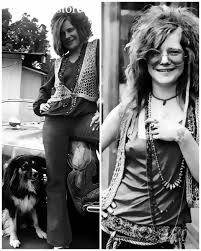In 1969, Madison Square Garden erupted in thunderous applause. Janis Joplin had just delivered a performance charged with raw passion, pouring every ounce of herself into “Piece of My Heart” and “Ball and Chain.” The audience rose to their feet, calling out her name, desperate for an encore. As the last notes drifted away, she gave a trembling wave, beamed a radiant smile, and exited the stage with her feather boa trailing behind her—a moment that seemed like pure triumph.
Yet, behind the scenes, the story was different. The roar of the crowd still vibrated through the walls as Janis quietly slipped into her dressing room alone. She closed the door, leaned against it briefly, then moved toward the small vanity. With hands that betrayed a slight tremor, she poured a glass of Southern Comfort. The distant cheers continued, muffled but persistent—almost a cruel reminder of the gulf between the stage and solitude.
Gazing into the mirror, she wiped the sweat from her forehead and took a long, slow sip. Her eyes, heavy with makeup and exhaustion, stared back at her. Though her voice had shaken the arena and her energy had ignited thousands, a familiar ache gripped her chest. Instead of joining the band or crew for post-show celebrations, she remained alone, tears quietly streaming down her face.
Later, when a close friend knocked softly and asked if she was alright, Janis didn’t respond immediately. Finally, eyes fixed on the floor, she whispered, “They all love me when I’m on stage. But offstage, no one really wants to know me.”
Her words carried the weight of a deeper wound than just fatigue. It was the emotional fracture she had carried since her youth in Port Arthur, Texas—where she was ridiculed for being different, mocked for her style, her laughter, her music, even her voice. The girl once labeled a “freak” had risen to become a queen of rock and blues, yet the loneliness persisted, untouched by fame.
Music gave her a sense of self, but it didn’t always bring connection. Onstage, she was adored, needed, and powerful. Offstage, she felt invisible. The stark contrast between the adulation she received and the quiet emptiness of her dressing room was almost unbearable.
Earlier that year, in a candid moment with a fellow musician, she confessed, “When I sing, I get to be my true self, and people want that. But the moment the music stops, I disappear.”
She longed for closeness that no crowd or record sale could provide. Often, after shows, she wandered hotel corridors barefoot, bottle in hand, knocking softly on doors of friends or acquaintances, simply hoping for a conversation. Frequently, there was no answer.
That night in 1969, after the applause had died and the venue emptied, she sat alone with her guitar, gently strumming in the darkness. The echoes of the audience had vanished, replaced by her soft humming. The voice that once moved thousands now sounded like a tender lullaby, filled with longing and sorrow.
The same voice that had made people weep, dance, scream, and confront their own pain was now expressing her own loneliness in a silent room with no one to listen. Her solitude wasn’t born from lack of success; it stemmed from knowing that while millions cherished her music, few truly saw the woman behind it.
In that empty dressing room, following the most triumphant moment of her tour, Janis Joplin was not a star, an icon, or a legend. She was simply a woman who gave everything she had onstage, still waiting quietly for someone to love her when the lights faded.
And in those solitary hours, the cheers and applause gave way to a profound truth: she was the most powerful voice of her generation, yet she felt utterly unheard.
